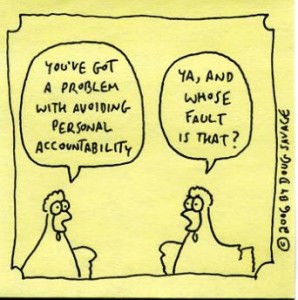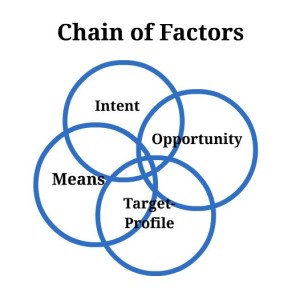Let’s take a look at the following accepted and politically correct phrasing used when referring to sexual assault.
“Rape and all forms of sexual assault are completely unacceptable, no matter the circumstances and is *never* the fault of the victim.”
Finding fault and placing blaming is a societal construct. These terms are used for assigning responsibility for a particular violation or negative event. The terms rape and sexual assault by definition establishes that the legal culpability (blame) for the event lie with the perpetrator of the assault.
The circumstances relate to the Chain of Factors the surround a violation. This Chain of Factors is made up of the confluence of the Perpetrator’s Intent to violate the Victim, the Perpetrator’s Means to Violate the Victim, the Perpetrator’s Opportunity to violate the Victim, and the Victim’s Target-Profile. (Also see the Violation Triangle)
Chain of Factors = Intent + Means + Opportunity + Target-Profile = IMOT
A Target-Profile is the combination of a person’s factors and attributes that raise or lower the person’s influence over a perpetrator’s Intent, Means, and Opportunity (IAO) to violate him or her. A person with a Likely-Target-Profile (LTP) is more apt to be victimized than a person with an Unlikely-Target-Profile (UTP). People with LTP have more Prey-Factors and less Anti-Prey-Factors. The reverse is true for a person with a UTP.
Likely-Target-Profile = More likely to be victimized
Unlikely-Target-Profile = Less likely to be victimized
Prey-Factors are a person’s actions, non-actions, attributes, behaviors, beliefs, attitudes, etc that make it MORE likely that a perpetrator will have the IMO to violate that person.
Anti-Prey-Factors are a person’s actions, non-actions, attributes, behaviors, beliefs, attitudes, etc that make it LESS likely that a perpetrator will have the IMO to violate.
Likely-Target-Profile: Prey-Factors > Anti-Prey-Factors
Unlikely-Target-Profile: Anti-Prey-Factors > Prey-Factors
A person can be responsible for some Prey-Factors and not responsible for others. For example, diminished mental and physical capacity is a Prey-Factor and creates an LTP. If this diminished capacity is the result of genetics or disability then the person is not responsible for this PF. If this diminished capacity is created by purposeful drinking or drugs, then the person IS responsible for this PF. Willingly engaging in high risk behaviors and spending time in high risk environments creates an LTP. Purposely, avoiding and abstaining from the same creates a UTP.
Most people have a distribution of Prey-Factors that can be described by the Bell Curve. Meaning that few people have an extreme LTP or UTP and most people falling somewhere in between.
In conclusion, sometimes people are responsible for creating an LTP that becomes a factor in the Chain of Factors that ultimately results in a culpable violation by a perpetrator(s). Other times people are not responsible for having a LTP that results in said violation. Sometimes a person creates a UTP and still the Chain of Factors results in a violation. Sometimes a person creates a UTP that results in the deterrence of a violation.
In all these situations, the Perpetrator is always at fault and should be blamed for committing the violation. But, the victim may or may not have had some responsibility in influencing the circumstances that led to the violation.

